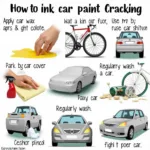Fixing minor car bumper scuffs yourself can save you time and money. This guide provides practical advice and step-by-step instructions on how to conduct car bumper scuff repair at home effectively. We’ll cover everything from assessing the damage to achieving a professional-looking finish, empowering you to restore your bumper’s appearance without breaking the bank.
Assessing the Damage: Know Your Scuff
Before you begin your car bumper scuff repair at home, it’s crucial to understand the extent of the damage. Is it a light scratch, a deep gouge, or a combination of both? Identifying the type of scuff will determine the appropriate repair method. Light surface scratches often only require a thorough cleaning and polishing, while deeper damage might necessitate filling and repainting. Examining the scuff closely under good lighting will give you a clear picture of the task ahead. This assessment is essential for selecting the right tools and materials, ensuring a successful repair.
After you’ve thoroughly washed and dried the bumper, inspect the scuff closely. Run your fingernail across it; if your nail catches, the scuff likely requires filling. If it’s smooth to the touch, you might be able to buff it out with a polishing compound. For more serious repairs, you might want to check out professional options for car bumper mobile repair.
 Close-up of a hand inspecting a car bumper scuff
Close-up of a hand inspecting a car bumper scuff
Gathering Your Supplies: Tools for the Job
Having the right tools and materials is key to a successful car bumper scuff repair at home. Depending on the severity of the damage, you will need some or all of the following: car wash soap, microfiber towels, rubbing compound, polishing compound, fine-grit sandpaper, plastic primer (for plastic bumpers), touch-up paint, clear coat, masking tape, and applicators. Consider the type of bumper you have; repairing a scratched black plastic car bumper will have slightly different requirements. Learn more on how to repair a scratched black plastic car bumper.
Repairing the Scuff: A Step-by-Step Guide
-
Clean the Area: Thoroughly wash the affected area with car wash soap and water, then dry it completely with a microfiber towel. This removes any dirt or debris that could interfere with the repair process.
-
Sand the Scuff (If Necessary): For deeper scuffs, use fine-grit sandpaper to smooth the area. Be gentle to avoid removing too much material.
-
Apply Primer (If Necessary): If the bumper is plastic and the scuff is deep, apply plastic primer to promote paint adhesion.
-
Apply Touch-Up Paint: Carefully apply touch-up paint to the scuffed area, using thin coats to prevent drips. Allow each coat to dry completely before applying the next. You might be interested in getting help for such repairs. Check out car body repairs bumper repairs.
-
Apply Clear Coat: Once the paint is dry, apply a few coats of clear coat to protect the repair and match the bumper’s finish.
-
Polish and Buff: After the clear coat has dried, use rubbing compound followed by polishing compound to blend the repair seamlessly with the surrounding area.
“A common mistake is applying too much paint at once,” says automotive expert, David Miller, Lead Technician at AutoRestore Solutions. “Multiple thin coats will yield a much smoother and more durable finish.”
Maintaining Your Bumper: Preventing Future Scuffs
Regular cleaning and waxing can help protect your bumper from minor scratches and scuffs. Parking carefully and avoiding tight spaces can also minimize the risk of damage. If you need help with your car bumper, you can learn more at how to repair my car bumper.
“Protecting your bumper is an investment in your vehicle’s overall appearance,” adds Miller. “A little preventative care can go a long way.” If you’re looking for specific bumper repair options, consider exploring car bumper repair rugby.
Conclusion: DIY Car Bumper Scuff Repair
Car bumper scuff repair at home is a manageable DIY project that can save you significant expense. By following the steps outlined in this guide and using the correct materials, you can effectively address minor bumper damage and restore your vehicle’s appearance. Remember to assess the damage carefully and choose the appropriate repair methods.
FAQs
- Can I repair any type of bumper scuff at home?
- Minor scuffs and scratches are generally suitable for DIY repair. However, significant damage may require professional attention.
- What if the scuff is on a colored bumper?
- The process is similar, but you’ll need to find a touch-up paint that matches your bumper’s color code.
- How long does the repair take?
- The repair time varies depending on the severity of the damage, but generally, it can be completed within a few hours, including drying time.
- Where can I find the right touch-up paint for my car?
- Auto parts stores and dealerships usually carry touch-up paint, or you can order it online using your car’s VIN.
- What if I’m not comfortable sanding the bumper?
- If the scuff is minor, you might be able to skip the sanding step. However, for deeper scuffs, sanding is necessary for a smooth finish.
- How can I prevent future bumper scuffs?
- Careful parking, avoiding tight spaces, and regular waxing can help protect your bumper.
- What if my bumper is made of a different material than plastic?
- The basic principles of repair are similar, but you might need to use different primers and paints depending on the material.
Need assistance? Contact us via WhatsApp: +1(641)206-8880 or Email: [email protected]. Our 24/7 customer service team is here to help.


